What is a Vacuum Tube?The vacuum tube is a device that was developed by English physicist John Ambrose Fleming for the first time in 1904, which contains electrodes to control electron flow. Generally, in a sealed container, it is used to control flow with the help of a vacuum. In early computers, it was also used as a switch or an amplifier, and it is also known as a valve or an electron tube. The below picture shows a different kind of vacuum tubes. 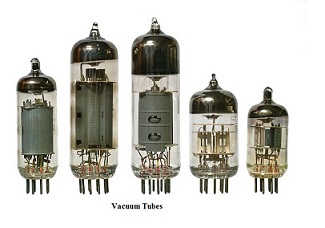
During the first half of the 1900s, it was used in televisions, sound recording, industrial automation reproduction, radar equipment, radios, and telephone network systems and is the predecessor of the modern transistor that means, as transistors may be used today, the vacuum tube was used in creative ways as electronically controlled rectifiers, oscillators, switches, and amplifiers. In older computer monitors and televisions, the CRT (cathode ray tube) was widely used as a screen is a kind of vacuum tube. First, it was invented as a basic component for electronic devices and most commonly used in the evolution of analog as well as digital computers in the first half of the twentieth century. The vacuum tube produces electrons and an anode as it was made of a cathode, and the anode collects the electrons called a diode. However, there were other kinds of vacuum tubes available, which were categorized on the basis of the number of electrodes presented. Then, these electrodes are surrounded typically in glass, in a casing; when energized enough, it can act as a conductor with all the air detached. As lightning travels through the air, in the same way, a pathway becomes for electrons. Therefore, it is commonly known as the vacuum tube due to the shape of the vacuum. Also, the vacuum tube produced a lot of heat as it needed massive amounts of power; because it required a heating filament for producing electrons. Due to a lot of heat, the components were quickly degraded; therefore, they burned out quickly. In order to work, three different power sources are also required by vacuum tubes, which are based on capacities and ratings. The power consumption and size became smaller with the progress of vacuum tube technology. Also, they were cost-effective, and transistors work effectively only for low frequencies. With the transistors in a cascade, a hundred transistors in parallel and wired together will be required for high frequencies. That led to the need for heat sinks, which creates massive heat. An equivalent transmitter needs significantly less power and only uses a single tube. Also, it can be coded with the help of forced air or water cooling. The speaker damping effect of vacuum tubes and solid-state amplifiers cannot repeat the peculiar distortion; hence, in sound amplifiers, the vacuum tubes are more common. The vacuum tube started to replace by the transistor in the 1950s. Due to the size of the transistors, they were become much ideal to use as the size of computing devices started to become smaller. In smaller computing devices, vacuum tubes did not fit as they were large in size, which led to becoming less useful. Additionally, today vacuum tubes are still used in high-end audio equipment and big radio stations, especially those using frequencies more than 50 MHz and energy levels more than 10,000 W; hence, the vacuum tube technology is not completely obsolete. Different Types of Vacuum TubeThe vacuum tube is an interesting cleaning element that is used in various ways for several purposes. In the vacuum setting, these tubes mainly contain a cathode and anode. There are various types of vacuum tubes, which are discussed below with their operating principles. 1. Diode Vacuum Tubes: The diode is the simplest form of the vacuum tube, which contains two terminals: an anode and a cathode. When the cathode is sufficiently heated, its electrons transfer from the surface due to the thermionic effect. If the cathode contains a higher electric potential and is applied to the anode, the cathode emits negatively charged electrons that are attracted to the anode. Then, the electric currents, via the convection, go in the direction of positive charges. 2. Therefore, the flow of electrons is always considered from the cathode to the anode. The main reason behind it, the current of negative charges going in the same route is equivalent to a current of positive charges in the opposite direction. The below picture is an example of Diode vacuum tubes. 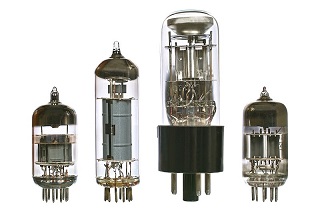
As compared to the cathode terminal, when the anode has higher electric potential, the released electrons get attracted to the anode. 3. Triode Vacuum Tubes: It is another type of vacuum tube where the electric currents flow from the high potential V+. However, a valve is still needed that allows controlling this flow. In a triode, more like a third terminal, a grid is needed that is placed between the cathode and the anode. As compared to the cathode, when the electric potential of the grid is lower, the cathode emits electrons that are repelled and help to find difficulties to reach the anode and movement of electrons between the terminals. If the grid is negative enough, its current gets blocked, obtaining the same effect that helps to close the valve in the hydraulic circuit. An image is given below that is an instance of a Triode vacuum tube. 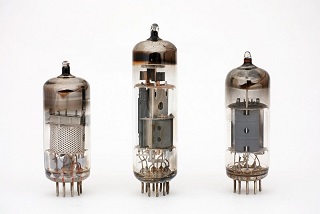
4. Tetrode Vacuum Tubes: The primary intention of the creation of the triode was related to the introduction of the tetrode vacuum tubes. Between the anode and the grid, the tetrode contains a fourth electrode called as the screen. The main objective of this advance component is to short the capacitance produced by the anode and the grid. The grid and the anode both work like a small-sized capacitor in a triode as they are located very close to one other, which may lead to instability and oscillations. While comparing with the cathode, if the screen consists of higher voltage but has lower voltage as compared to the anode, it reduces the inherent capacitance of the grid and the anode through working as an electrostatic screen between both (grid and anode). The below picture is an example of Tetrode vacuum tubes. 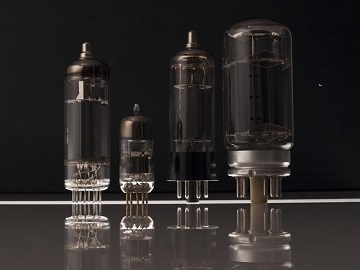
At the anode, with the help of giving some fractions of the output signal, the screen is also set to work in an ultra-linear structure. With respect to the cathode, the screen is positive in a tetrode. Therefore, the electrons emitted from the cathode that are attracted by the screen in some amount go toward the anode. Consequently, through the screen, there will be a smaller current flow. This effect is used at the time of configuring vacuum tubes to work in ultra-linear modality or distributed load. Instead of applying a fixed voltage to the screen, this configuration is acquired with the help of feeding back a percentage of the output signal of the anode to it. The required anode output signal's percentage is offered to the screen with the help of connecting it to tap from the output transformer. The current through the screen offers a kind of negative reaction, and the value of distortion falls minimally with the appropriate percentage of anode signal, which led to reduce power efficiency. This appropriate percentage is determined by the specific electronic vacuum tubes used. Generally, this percentage is set around 43% in most of the available designs of power amplifiers. 5. Pentode Vacuum Tubes: The main idea of the creation of the pentode was a further refinement to the tetrodes vacuum tubes. In this type of vacuum tube, whenever the cathode emits the electrons and reaches the anode, there are more chances that they have enough energy to stimulate the emission of secondary electrons from the anode itself. However, when secondary emission electrons reach the grid, they might be caused to instability and oscillations. There is the fifth electrode, called suppressor, that is used by pentodes to prevent secondary emission electrons. Generally, the suppressor is directly connected to its cathode with the help of an explicit connection between the corresponding pins or using a connection inside the vacuum tube. The below picture shows how the pentode vacuum tube looks. 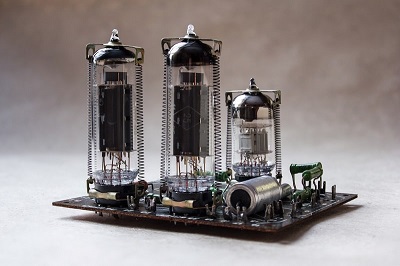
Principles of Vacuum TubesA vacuum tube or electron tube contains two or more electrodes that are separated through ionized gas or vacuum at low pressure. Through the tube from one electrode to another, its operation is depending on the basis of the generation and transfer of electrons. The cathode is the source of the electron, usually a metallic electrode emitted by the cathode. A magnetic field, an electric field, or both works for controlling the movement of the electrons emitted by the cathode. A magnetic field may be produced through a permanent magnet or an electromagnet outside the tube. In simple form, the positive electrode (a plate or anode) appeals and accelerates the electron, and the negative electrode (cathode) repels and slows it. History of Vacuum tubesThe vacuum tube is a device that was first developed by English electrical engineer and physicist John Ambrose Fleming in 1904, which was also known as Fleming valve, vacuum diode, thermionic valve, thermionic tube, or Kenton. Fleming was not only known for its electronics contributions, but they also played a vital role in the field of wireless telegraphy, photometry, and electric measurements. At University College, he became a famous teacher and a consultant to the Edison Electric Light Company. In 1929, he was knighted as he had made different advances in the field of electrical and electronic engineering. Fleming was also a good author; he wrote over a hundred particular books and papers; some common were: The Alternate Current Transformer in 1889, In 1906, The Principles of Electric Wave Telegraphy. Until then use of Fleming's diode was superseded by solid-state electronic technology, it was used in radars and radio receivers for many decades afterward. Vacuum tubes allowed much development in the first half of the 20th century, such as the first electronic digital computers, long-distance telephone service, radio broadcasting, and television. Although vacuum tubes had almost been replaced by transistors, the use of vacuum tubes may still be seen in certain devices like microwave ovens, display devices for computers and television sets, and high-frequency transmitters on space satellites. In the 1880s, an effect was discovered by Thomas Edison, which was not used for useful work at the time. Although the name "Hammer's Phantom Shadow was given to this phenomenon, later it became known as the "Edison Effect "when Edison patented the bulb in 1883. As compared to the hot filament, if the extra electrode is made more positive, a direct current moves through the vacuum. An extra electrode is also known as "plate" or "anode." Advantages of vacuum tubesAlthough vacuum tube was an earlier technology, it contains some benefits that are discussed below:
Disadvantages of vacuum tubes
Next TopicWhat is a VDU
|
 For Videos Join Our Youtube Channel: Join Now
For Videos Join Our Youtube Channel: Join Now
Feedback
- Send your Feedback to [email protected]
Help Others, Please Share









